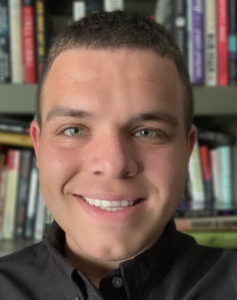 The February 2022 Industry Insider Interview at OPB is with James McGowan, a literary agent at BookEnds Literary Agency. He joined the agency as an intern and worked in multiple departments. Now, as an agent, he represents an accomplished list of award-winning writers and illustrators, focusing on “illustrated projects for young readers (board books, picture books, chapter books, and middle grade) as well as adult nonfiction and mystery/suspense novels.”
The February 2022 Industry Insider Interview at OPB is with James McGowan, a literary agent at BookEnds Literary Agency. He joined the agency as an intern and worked in multiple departments. Now, as an agent, he represents an accomplished list of award-winning writers and illustrators, focusing on “illustrated projects for young readers (board books, picture books, chapter books, and middle grade) as well as adult nonfiction and mystery/suspense novels.”
In addition, James is a picture book author himself. His first book, Good Night, Oppy!, was published this past year. Clearly, he knows this industry inside and out!
And just because fun facts are great to know, here’s additional information about James:
- He’s an enormous Jeopardy! fan.
- He considers himself a professional snacker.
- He has a deep love of science.
- He loves a good laugh and probably provides some laughs, being fluent in sarcasm.
- He currently lives on Staten Island, where he was born and raised.
Let’s share some links and get right to the interview!
JW: When did you discover your love for reading and writing?
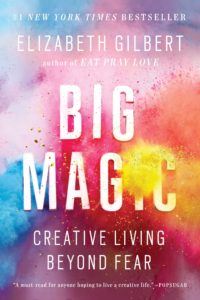 JM: In the most cliché answer: I’ve always been a reader. I can remember my mom teaching me to read using a board book (whose title I sadly cannot remember). I remember taking a book to parties and sitting in the corner, and begging to stop at bookstores. It’s something that has always been with me.
JM: In the most cliché answer: I’ve always been a reader. I can remember my mom teaching me to read using a board book (whose title I sadly cannot remember). I remember taking a book to parties and sitting in the corner, and begging to stop at bookstores. It’s something that has always been with me.
Writing came much later, after I graduated from college and listened to Big Magic by Elizabeth Gilbert on my commutes to and from the BookEnds office. I always had ideas, but that book made me think I can see them through.
JW: You began working at BookEnds Literary Agency in 2015 as a summer intern. How did you go about getting this internship?
JM: I applied to just about every internship program one could find in publishing, and BookEnds was one of the only two or three that replied to me. Finding an internship in this industry is all about persistence!
JW: What was the most helpful lesson you learned as an intern?
JM: Ask questions. I am by nature a question-asker but it is crucial that every intern abandon any level of fear and just ask the question they have. There is no stupid question when you’re learning a field. Also, it makes you look engaged, interested, and people remember you better when they talk to you more.
JW: What was it about picture books that made you decide this is where you want to be?
JM: For me, it’s the combination of text and illustration. Picture books are a work of art and that’s because of the collaboration. Seeing your book come to life is a feeling no picture book author will ever get tired of.
JW: What’s your favorite part of being a literary agent?
JM: Much like above… the collaboration. I’m not sure of another job where you work this closely with creators in both a creative and strategic setting. I love having a roster of brilliant minds that I can learn from and create with.
JW: Since joining BookEnds, you have worked in various departments. How do these different experiences help you when representing your clients?
JM: This has made me a better agent, hands down. I would not trade my time as an assistant for anything. I can speak confidently in every aspect of running a literary agency, from the accounting department to contracts, taxes, subsidiary rights, social media, etc. I’ve always felt I can bring my clients a deep understanding of how the agency can and will serve them, and I’ve always appreciated that.
JW: As an agent who represents both writers and illustrators, how is the process different between the two?
JM: Oh, totally different! But… not? At the same time? I mean, authors do not have the guide that illustrators do in terms of story. They’re crafting and creating that from scratch, whereas the illustrator has the author’s roadmap (manuscript). But each of them are creating details and story arcs that the other is not. An illustrator can add a visual arc to a story that the writer never could have imagined. The process is obviously different in that one is text and one is art, but the creative process, I imagine, is quite similar.
JW: I have noticed more and more authors are getting into self-publishing. As an agent, what do you think about that?
JM: This really depends on what the creator’s goal is. If you want to self-publish, then you wouldn’t need an agent. If you wish to traditionally publish your book, an agent is the first step. Most publishers do not accept submissions by unagented creators so you’ll need an agent to submit, but we’re not just here to submit for you. A good agent will negotiate your offers, your contracts, manage schedules, advocate for you in terms of marketing, track payments and royalty statements, seek new opportunities for subsidiary rights, and more. All of that is not something most authors are able to do, and in my opinion is worth the commission.
JW: What do you look for when you get a story that features or covers issues involving the LGBTQ+, BIPOC, and other groups with historically lesser representation so that the story champions these groups?
JM: Overall, I’m looking for good storytelling. I, like any reader, wants to be swept away by something. I want to invest myself into the story the author or illustrator wants to tell. That is the same for any creator. When working with marginalized creators, I see my role as one of amplification. How can I assist in getting their story and experiences out there?
JW: Making connections with an agent for brand new writers, while extremely important, can be pretty intimidating. What advice would you give to a new writer on the scene with making these meaningful connections?
JM: Don’t overthink it. Agents are humans, and we all just want to connect with others.
JW: I have heard you appreciate a good laugh. Why do you feel humor is important in picture books?
JM: Humor, to me, is the most foolproof way of captivating someone’s attentions. When we’re dealing with kiddos, whose attention is sacred, humor is your best friend.
JW: With the vast number of ways humor can express itself, what do you look for in stories with humor?
JM: I’m open!
JW: What type of humor turns you off?
JM: I’d say I’m not typically a potty humor person, but if something is done inventively, it could totally work for me.
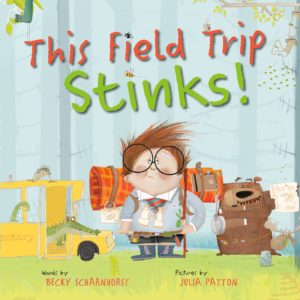 JW: One upcoming humorous book from an author you represent, Becky Scharnhorst, caught my attention, This Field Trip Stinks!, the follow-up to My School Stinks! What elements of a picture book make it a good candidate for a sequel?
JW: One upcoming humorous book from an author you represent, Becky Scharnhorst, caught my attention, This Field Trip Stinks!, the follow-up to My School Stinks! What elements of a picture book make it a good candidate for a sequel?
JM: Stuart (the main character) is one of my favorite picture book characters ever. In terms of what makes a good sequel for a humorous picture book, to me, it’s just that: a great focal character.
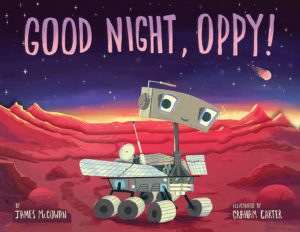 JW: Also, congratulations, as you recently had your own picture book published, Good Night, Oppy! Space books were my favorite as a kid. How did you come up with the idea for this book?
JW: Also, congratulations, as you recently had your own picture book published, Good Night, Oppy! Space books were my favorite as a kid. How did you come up with the idea for this book?
JM: Thank you! Mine, too. When the news broke about Oppy, I heard it on the radio during my commute to work. As soon as I got into the office, I was chatting with my agent about it and the story came to life from there.
JW: Finding a way to make science appealing to young readers is so important. What advantages do you see to using fictionalized characters and stories to present this material?
JM: This is a great question. It really depends on the science to me, but I think it’s a great way of hooking a younger reader. To me, Oppy was instantly loveable. By following her journey in the book, I hope readers were learning a bit more about uncrewed space travel.
JW: Was there anything about the process of having your book published that took you by surprise, having worked in the industry?
JM: Ha! No, not really. I knew what to expect. Well, maybe just the general anxiety of it all. I did not realize how much pressure one can feel when gearing up for a publication day.
JW: On Twitter, you encourage all clients to celebrate new deals at least twice, and your favorite part is hearing how clients celebrate the news. What’s been your favorite celebration story from a client?
JM: This is my favorite part. One of my clients has her go-to coffee shop that she runs to get her favorite latte from. Some of my clients go out to dinner. One person finds a celebration that ties into their book’s subject (i.e. buying themselves a space-themed gift for a space-themed book).
JW: How did you celebrate the news your book was getting published?
JM: Super low key. I was TIRED. Ha! My family did get me a cake and sang happy birthday which I thought was funny. But otherwise, I just accepted the love on social media, and really just appreciated the moment for what it is, which is an incredible achievement.
JW: On social media, you’re pretty active as an agent. What are the benefits of being on social media regularly as an agent?
JM: Connection. Community. Especially as a younger agent, building your reputation as a kind person that others would want to work with, social media can be incredibly useful. I’ve always seen it as connecting with people and a place to share what I’m working on.
JW: Okay, James, it’s time for the SIX QUESTION SPEED ROUND with lightning-fast questions and answers please! Are you ready?
JM: Of course not, but here we go…
JW: Name your favorite sitcom.
JM: You’re kidding me right now. I have lots! I have always loved Friends. Brooklyn 99 and New Girl were more recent favorites. The show I cannot shut up about right now is Abbott Elementary.
JW: As a professional snacker, name your go-to snack and, as a daily-double, any snacks you do not like.
JM: Goldfish. A snack I do not like…. Potato chips. I’ve always found them greasy! But I do liked baked potato chips.
JW: If you could write questions for Jeopardy!, provide the category you would create for your questions.
JM: Children’s books, of course. Or snacks!
JW: Five things we’d see if we checked out your office.
JM: A ton of books. Approximately .5 million paperclips. Post-its everywhere. My iPad. Schweppes lemon lime seltzer.
JW: What’s a recent picture book that really got your attention?
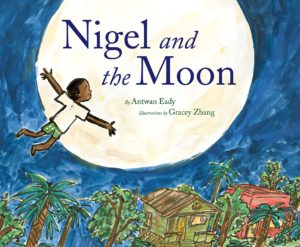 JM: Nigel and the Moon by Antwan Eady and Gracey Zhang.
JM: Nigel and the Moon by Antwan Eady and Gracey Zhang.
JW: What’s the most important trait you bring to the keyboard?
JM: Honesty!
JW: Thanks so much, James!
 Joshua Walls is a children’s author and travel writer who isn’t afraid to fuse, challenge, or deconstruct genres in the pursuit of creating compelling stories. Currently, he lives in Sarasota, FL where he’s pursuing a BFA in Creative Writing at Ringling College of Art and Design. He’s also the co-founder and co-host of the Fluff It podcast.
Joshua Walls is a children’s author and travel writer who isn’t afraid to fuse, challenge, or deconstruct genres in the pursuit of creating compelling stories. Currently, he lives in Sarasota, FL where he’s pursuing a BFA in Creative Writing at Ringling College of Art and Design. He’s also the co-founder and co-host of the Fluff It podcast.


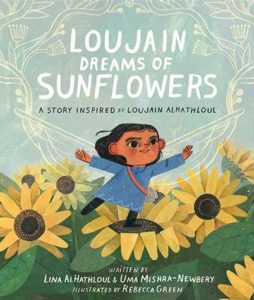
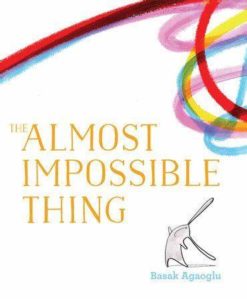
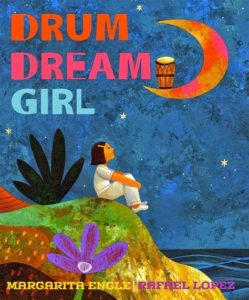
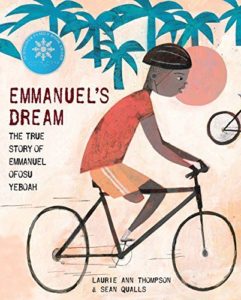
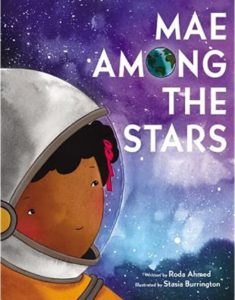
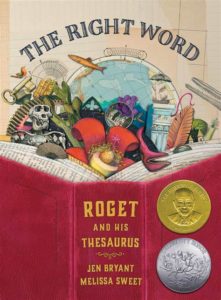
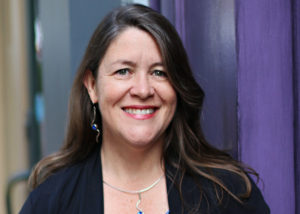
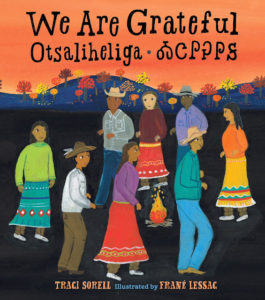
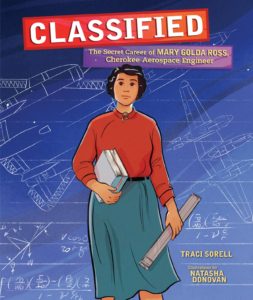
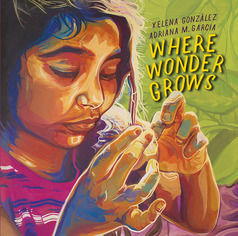
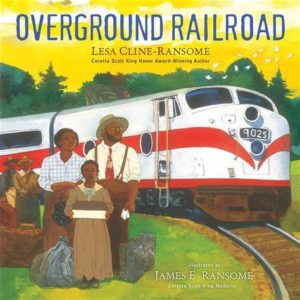
 Kelly Light lives in Amherst,
Kelly Light lives in Amherst,